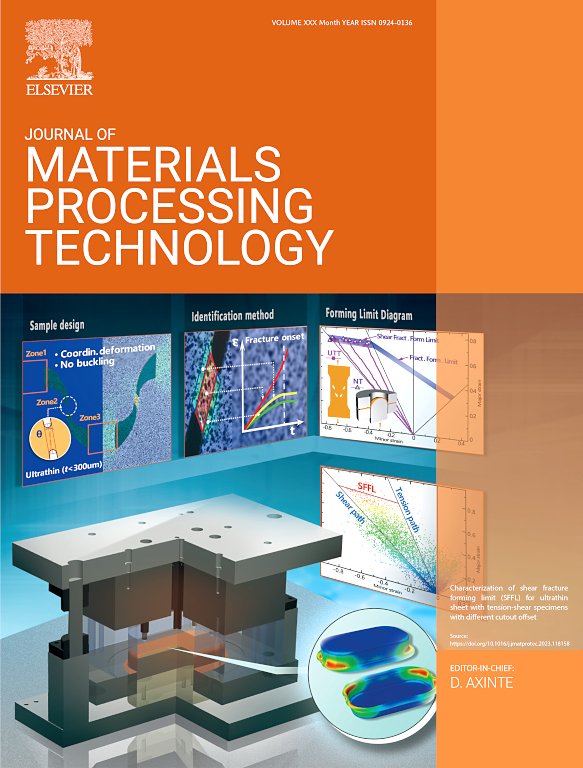Investigating the effects of powder feeding rate on microstructure transformation in linear laser beam additive manufactured thick-walled structures
IF 6.7
2区 材料科学
Q1 ENGINEERING, INDUSTRIAL
Journal of Materials Processing Technology
Pub Date : 2024-10-21
DOI:10.1016/j.jmatprotec.2024.118642
引用次数: 0
Abstract
The coarse columnar crystals that grow through multiple layers are commonly observed in laser additive manufactured structures, with fractures tending to occur in regions where there are abrupt changes in grain morphology. This can lead to a degradation of the mechanical properties of the samples. In this study on laser additive manufacturing, thick-walled structures made of 304 stainless steel were created using a linear beam spot with a rectangular powder feeding nozzle. By adjusting the powder feeding rate to influence the thermal cycling characteristics during the laser additive manufacturing process, a hierarchical grain structure that combines coarse and fine equiaxed grains was achieved, enhancing the forming efficiency and overall mechanical performance of the structure. The results from the thermal cycling characteristics and microstructure analysis indicate that increasing the powder feeding rate during the additive manufacturing process can decrease the hierarchical cooling rate, temperature gradient, and heat accumulation effect. This reduction in turn decreases the grain size and facilitates the transformation of columnar crystals into equiaxed crystals. Furthermore, the transformation of low-angle grain boundaries into high-angle grain boundaries in the interlayer region helps to reduce stress concentration, weaken anisotropic tendencies, and mitigate intergranular fracture tendencies, ultimately improving the mechanical properties of the overall structure. In actual engineering applications, the powder flow can be adjusted to control the temperature gradient and cooling rate of the deposition layer, thereby altering the grain morphology and optimizing the mechanical properties of additive manufacturing parts.
研究粉末进料速度对线性激光束添加剂制造厚壁结构微观结构转变的影响
在激光添加剂制造的结构中经常可以观察到通过多层生长的粗柱状晶体,而断裂往往发生在晶粒形态发生突然变化的区域。这会导致样品的机械性能下降。在这项关于激光快速成型的研究中,使用带有矩形送粉喷嘴的线性光束光斑制造了由 304 不锈钢制成的厚壁结构。在激光增材制造过程中,通过调整送粉速度来影响热循环特性,实现了粗细等轴晶粒相结合的分层晶粒结构,提高了结构的成型效率和整体机械性能。热循环特性和微观结构分析的结果表明,在增材制造过程中提高粉末喂料速率可降低分层冷却速率、温度梯度和热累积效应。这种降低反过来又会减小晶粒尺寸,促进柱状晶向等轴晶的转变。此外,层间区域的低角度晶界转变为高角度晶界有助于减少应力集中,削弱各向异性倾向,减轻晶间断裂倾向,最终改善整体结构的机械性能。在实际工程应用中,可以通过调整粉末流动来控制沉积层的温度梯度和冷却速度,从而改变晶粒形态,优化增材制造部件的机械性能。
本文章由计算机程序翻译,如有差异,请以英文原文为准。
求助全文
约1分钟内获得全文
求助全文
来源期刊

Journal of Materials Processing Technology
工程技术-材料科学:综合
CiteScore
12.60
自引率
4.80%
发文量
403
审稿时长
29 days
期刊介绍:
The Journal of Materials Processing Technology covers the processing techniques used in manufacturing components from metals and other materials. The journal aims to publish full research papers of original, significant and rigorous work and so to contribute to increased production efficiency and improved component performance.
Areas of interest to the journal include:
• Casting, forming and machining
• Additive processing and joining technologies
• The evolution of material properties under the specific conditions met in manufacturing processes
• Surface engineering when it relates specifically to a manufacturing process
• Design and behavior of equipment and tools.
 求助内容:
求助内容: 应助结果提醒方式:
应助结果提醒方式:


